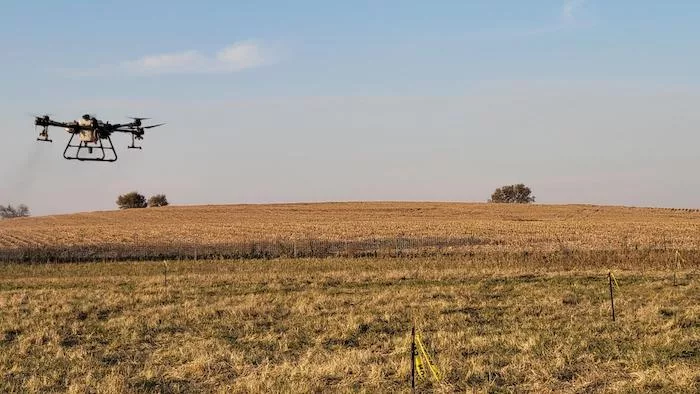Iowa City, IA – Rantizo, a precision agriculture company, has received the first approval from the federal government to employ a drone for agricultural applications, according to a company press release.
The Federal Aviation Administration granted approval for the company to operate the DJI Agras T-30 drone for agricultural purposes.
The T-30 was initially launched in 2021, but could not be used without FAA approval because the drone weighs more than 55 pounds, according to the press release. A fully loaded T-30 can weigh up to 169 pounds. The new drone is expected to become available for sale in December.
With the exemption, Rantizo becomes the first company in the U.S. to receive the necessary approvals to operate a drone for agriculture.
The new drone represents a substantial innovation, the press release quotes Rantizo Special Projects Manager Beau Brown as saying.
“The DJI T-30 represents a three-generation jump in technological advancements in aerial drone sprayers, such as new avionics, obstacle avoidance and more intelligent field management,” he said. “These tools, combined with Rantizo’s expertise and support, will ensure our contractors and pilots continue to be the most successful in the drone application industry."
The device fits on the back of a flatbed truck and could meet demand for growers in the year ahead, said Rantizo Marketing Manager Emily Carlson.
“We’ve been seeing demand for bigger drones since day one,” Carlson. “However, we are calculated in what products we offer within our system for drone applications and when we release them. Headed into the 2022 season, our approvals for use of the T-30 will be a game changer for both Rantizo contractors and the growers they serve.”
The release cites several potential benefits for on-farm drone usage:
- Little to no crop damage when compared to conventional sprayers
- Major cost savings on inputs with spot-spraying capability
- Improved soil health due to no machinery-caused soil compaction
- More versatility in application, less reliance on weather due to precise application
- Additional method of cover crop broadcast seeding
The company offers turnkey systems to make the use of agricultural drones easy and legal for most growers. Growers will also have to evaluate the best way to fit drones into their operations, said Rantizo Director of Sales Sam Pendleton.
“Ag retailers want to stay on the cutting edge,” he said. “It’s what their customers expect. But at the same time, they have to consider how drone applications could work in their operation. Whether that’s covering the awkward acres to make their ground rigs more efficient, adding a more precise option to their aerial fleet, or simply gaining the ability to target site-specific areas to provide cost-effective options to their customers. Rantizo has been committed to providing those retailers with a system designed to do all of that for them in a safe and legal way; the addition of the T-30 is only going to enhance those benefits.”
Past Rantizo drone models include the 10 Liter DJI Agras MG-1P. The Iowa City-based startup added proprietary technology such as their upgrade kit and additional waivers for multi-drone swarming to optimize productivity in the field.
Larger drones mean greater payload capacity, speed, and more functions, which means drones could fill more roles, according to the press release.
Consumer command continues to drive the company, said CEO Michael Ott.
“In our case we have two customer segments to consider: our network of contractors who want the most productive drone application system available to provide services, and their farmer customers who want both precision and cost-effective options for in-field applications,” he said. “Whether we tackle this with multiple drones, or larger drones, the result is a win-win for both and that’s always what we keep at the forefront. Our approvals for the T-30 are just the next step in the evolution of where drone applications are headed for ag.”
Rantizo received their initial approvals for single drone spraying operations from the FAA in July of 2019.



![[Technology Corner] A Big Step Forward for Interoperability & Data Sharing](https://www.precisionfarmingdealer.com/ext/resources/2025/12/12/A-Big-Step-Forward-for-Interoperability--Data-Sharing.webp?height=290&t=1765565632&width=400)


